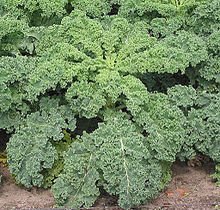Kale
| Kale | |
|---|---|

Curly kale, one of the many varieties of kale
|
|
| Species | Brassica oleracea |
| Cultivar group | Acephala Group |
| Origin | Unknown, but before the Middle Ages |
| Cultivar group members | Many; see text. |
| Nutritional value per 100 g (3.5 oz) | |
|---|---|
| Energy | 207 kJ (49 kcal) |
|
8.8 g
|
|
| Sugars | 2.3 g |
| Dietary fiber | 3.6 g |
|
0.9 g
|
|
|
4.3 g
|
|
| Vitamins | |
| Vitamin A equiv. |
(63%)
500 μg
8198 μg
|
| Thiamine (B1) |
(10%)
0.11 mg |
| Riboflavin (B2) |
(11%)
0.13 mg |
| Niacin (B3) |
(7%)
1.0 mg |
| Pantothenic acid (B5) |
(18%)
0.9 mg |
| Vitamin B6 |
(21%)
0.27 mg |
| Folate (B9) |
(35%)
141 μg |
| Choline |
(0%)
0.8 mg |
| Vitamin C |
(145%)
120 mg |
| Vitamin E |
(10%)
1.54 mg |
| Vitamin K |
(671%)
705 μg |
| Minerals | |
| Calcium |
(15%)
150 mg |
| Iron |
(12%)
1.5 mg |
| Magnesium |
(13%)
47 mg |
| Manganese |
(31%)
0.66 mg |
| Phosphorus |
(13%)
92 mg |
| Potassium |
(10%)
491 mg |
| Sodium |
(3%)
38 mg |
| Zinc |
(6%)
0.6 mg |
| Other constituents | |
| Water | 84.0 g |
|
|
|
|
|
| Percentages are roughly approximated using US recommendations for adults. | |
| Nutritional value per 100 g (3.5 oz) | |
|---|---|
| Energy | 117 kJ (28 kcal) |
|
5.63 g
|
|
| Sugars | 1.25 g |
| Dietary fiber | 2 g |
|
0.4 g
|
|
|
1.9 g
|
|
| Vitamins | |
| Vitamin A equiv. |
(85%)
681 μg
18246 μg
|
| Thiamine (B1) |
(5%)
0.053 mg |
| Riboflavin (B2) |
(6%)
0.07 mg |
| Niacin (B3) |
(3%)
0.5 mg |
| Pantothenic acid (B5) |
(1%)
0.05 mg |
| Vitamin B6 |
(11%)
0.138 mg |
| Folate (B9) |
(3%)
13 μg |
| Choline |
(0%)
0.4 mg |
| Vitamin C |
(49%)
41 mg |
| Vitamin E |
(6%)
0.85 mg |
| Vitamin K |
(778%)
817 μg |
| Minerals | |
| Calcium |
(7%)
72 mg |
| Iron |
(7%)
0.9 mg |
| Magnesium |
(5%)
18 mg |
| Manganese |
(20%)
0.416 mg |
| Phosphorus |
(4%)
28 mg |
| Potassium |
(5%)
228 mg |
| Sodium |
(2%)
23 mg |
| Zinc |
(3%)
0.24 mg |
| Other constituents | |
| Water | 91.2 g |
|
|
|
|
|
| Percentages are roughly approximated using US recommendations for adults. | |
Kale (English IPA /keɪl/) or leaf cabbage refers to certain vegetable cultivars of the plant species Brassica oleracea. A kale plant has green or purple leaves and the central leaves do not form a head (as with headed cabbages). Kales are considered to be closer to wild cabbage than most domesticated forms of Brassica oleracea.
Kale bears semblance to "kail", a variant of "cawul" (from Scotland and northern England) for various cabbages.
Until the end of the Middle Ages, kale was one of the most common green vegetables in Europe. Curly-leaved varieties of cabbage already existed along with flat-leaved varieties in Greece in the fourth century BC. These forms, which were referred to by the Romans as Sabellian kale, are considered to be the ancestors of modern kales.
Russian kale was introduced into Canada, and then into the United States, by Russian traders in the 19th century.
During World War II, the cultivation of kale in the U.K. was encouraged by the Dig for Victory campaign. The vegetable was easy to grow and provided important nutrients missing from a diet because of rationing.
Some varieties can reach a height of six or seven feet, while others are compact, symmetrical and of good quality for eating. Many, however, are coarse and indigestible. Most kales are annuals or biennials. Kale seeds resemble those of cabbage in size, form, and color.
One may differentiate between kale varieties according to the low, intermediate, or high length of the stem, along with the variety of leaf types. The leaf colours range from light green to green, to dark green and violet-green, to violet-brown.
...
Wikipedia
